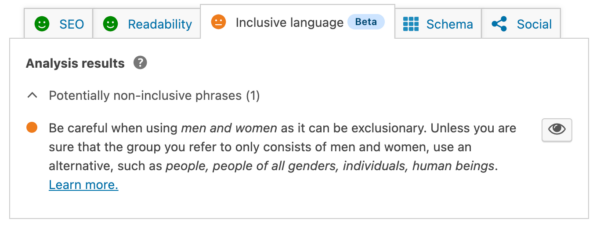What is inclusive language?

You might have been hearing more and more about it in the last few years: inclusive language. But what do people mean by it exactly? Is it a new thing? And why should you think about it when writing web copy? Find the answer to all of these questions in this post. We’ll do some myth-busting too!
Inclusive language
First things first: What is inclusive language? Inclusive language is language that avoids terms that might exclude marginalized groups of people. Typically these are terms that perpetuate prejudice, stigma, or erasure. Inclusive language favors alternatives over these terms that are less likely to be experienced as harmful or exclusionary. At the same time, these alternatives aim to keep the intended meaning.
Advocates of inclusive language generally strive for a more inclusive society. Language is an important aspect of society and it’s known to have the power to normalize ideas or beliefs. Therefore avoiding terms that imply sexist, racist, ableist, or otherwise biased ideas, can make more people feel genuinely part of society.
Some examples of inclusive alternatives
As this may sound complicated, let’s show some examples to demonstrate how this works.
Firemen vs firefighters
Take a look at this example:
” What happened? I saw all these firemen passing by!”
The word firemen generates a male or masculine image of the word in your mind. However, firefighters don’t have to be men. So, unless you’re referring to a group of male firefighters specifically, a better and more accurate alternative would be firefighters. A better sentence here would be:
” What happened? I saw all these firefighters passing by!”
By using this word in the right context you’re making sure all firefighters, whatever their gender, feel addressed, seen, or heard.
Inclusive language is context and language-specific
Inclusive language is a nuanced subject. What is or isn’t inclusive can depend on the context of the word. Some words are derogatory on all occasions; other words’ appropriateness can depend on the way they are used in a sentence.
For instance, in English using the word seniors when referring to older people is considered non-inclusive, while seniors when referring to children in high school is considered perfectly fine. At the same time, in Dutch, the word senioren (the literal translation of seniors) is actually considered more appropriate than oudere mensen (literal translation of older people). So what’s inclusive or not can really differ per context and per language.
Why write inclusive web copy?
So why would you write more inclusive content for the web? Well, when you’re creating content for your website you probably want as many people as possible to see, read and enjoy it. If you want people to feel seen and heard in your content it’s not only ethical but also smart to avoid certain words and phrases. By writing more inclusively you can give more people a better user experience as you’re making your content more accessible and relatable. That in itself is already a great reason to write more inclusively.
But it has more advantages. Creating inclusive content allows you to broaden your audience: it’s more likely people will engage with, link to, or share your content if they feel like you’ve written it for them. Which, in turn, is great for SEO, not to mention conversion. In fact, Google’s John Mueller stated on Twitter that they value and promote writing more inclusively as well. And as he says: “You might not get it right all the time but taking steps to get better matters too.”
Read more about the relationship between inclusive content and SEO.
Myths about inclusive language
Let’s conclude this post by debunking some myths that exist around the inclusive language phenomenon.
Inclusive language doesn’t have any real-life effects
Inclusive language has real impact on real people. Words have the power to hurt people, for example by making them feel dehumanized or invisible. But they also have the power to make people feel respected, seen, and valued.
And it’s not just about temporary feelings. Language has the power to influence how we think about ourselves and the world around us. For example, if you keep hearing the phrases “First World” and “Third World” over and over, it may reinforce the idea that some regions of the world are superior to others. So, language has the power to normalize certain ideas or beliefs. If you’d like to learn how this works, read this article about the power of everyday language.
Inclusive language is a new invention
The topic of inclusive language has been quite popular lately. This may make it seem like it’s a new invention. But language has always been evolving alongside social and cultural norms. And people have been actively pushing for language to change as social and cultural norms change.
A good example of this is the history of the pronouns “he” and “they” in English. In the 18th century, grammarians argued that the pronoun “he”, rather than “they”, should be used when someone’s gender is unknown. They claimed that such use of “he” was gender-neutral. But with the rise of the women’s rights movement, this rule began to be used a weapon against women. For example, the fact the United States Constitution refers to members of congress with “he” was used as an argument to prevent women from running for Congress. Unsurprisingly, many people felt that this “gender-neutral” use of “he” was not very inclusive. Over time, this pushback led to the decline of “he” to refer to someone of unknown gender. Today, “they” is the most common pronoun to use in such contexts.
The advice on inclusive language never changes
Our understanding of the world is always evolving. This means that over time, our view of what is and isn’t inclusive can change as well.
For example, terms like “handicapped” and “special needs” were common in the past. But over time, people realized the importance of having a neutral, non-euphemistic term to refer to people with disabilities. That’s why today, many inclusive language guides recommend the term “person with a disability”. They also advise against the use of “disabled person”, on the grounds that it reduces a person to their disability. However, this advice is starting to become outdated as well. While a lot of people with disabilities do prefer the term “person with disability”, many others prefer “disabled person”. For example, because disability is an important part of their identity. So the more up-to-date inclusive language guides accept both “person with disability” and “disabled person” as inclusive terms.
Such changes can sometimes lead to confusion or frustration. Can’t we just settle on what language is inclusive once and for all? Are people just adding all these new rules to make our lives more difficult? I get it, it would be nice if things were less complicated. But hopefully, it helps to understand that these changes happen because we are always learning and evolving.
You should feel bad for using non-inclusive language
It’s not a nice feeling when you realize you’ve used language that may have hurt others. But we have all been there. Even the most dedicated people still make mistakes and are learning. Since our understanding of inclusive language is evolving, it is natural to make mistakes along the way. It doesn’t make you a bad person if you have (unintentionally) used non-inclusive language. In the first section of this article on Medium the writer does a good job of explaining this.
Inclusive language is language that makes everyone happy
Making everyone happy is impossible. Inclusive language is about avoiding language that harms already marginalized groups of people, for example through stereotyping or erasing them. But this doesn’t mean everyone will be happy with it. For example, if someone holds exclusionary beliefs, they may feel unhappy when they see inclusive language. Same goes for someone who doesn’t understands the point of inclusive language and thinks its a waste of time.
Inclusive language is language that doesn’t offend anyone
Non-inclusive language is often offensive to people, but not all language that offends people is non-inclusive. Being offended is a subjective feeling – people can get offended by different things. For example, a person who expresses racist views may be offended if someone calls them racist. This doesn’t mean that calling racist behavior racist is not inclusive. There is a difference between language that causes personal offense and language that causes harm. Inclusive language is about avoiding the latter.
How to write more inclusively
So now you know what it is (and isn’t) and why you should use it. But how to make sure your content is inclusive? There are many guides on the internet on how to write more inclusive. So you might feel overwhelmed and not 100% up to date on best practices regarding inclusive language. We understand! It can be difficult because you might not be aware of potentially harmful words. Even when you are, you’d also need to know the alternatives! Also, as we explained, guidelines might change and that’s hard to keep up with.
Fortunately, Yoast can help you with an easy solution if you create content on WordPress or Shopify. It’s our Inclusive language analysis in Yoast SEO. It will check your copy for non-inclusive terms. These checks are developed by our in-house linguists, in cooperation with Maxwell Hope from the University of Delaware. The analysis will highlight the words that could be non-inclusive and will also provide alternatives. Check out how it works in this screenshot:

It checks for problematic terms in the following categories: Age, appearance, race, culture, ethnicity, disability, neurodiversity, gender and socio-economic status. Here you’ll find an overview of these categories. It’s opt-in, so you can switch it on if you care about this topic and want to make great content for everyone!

